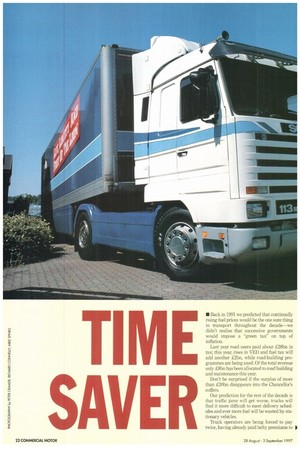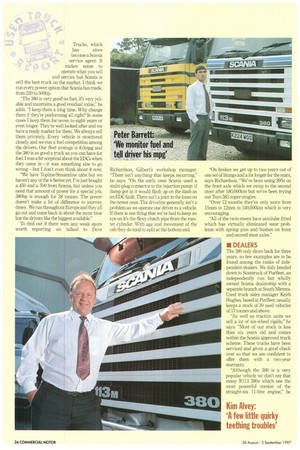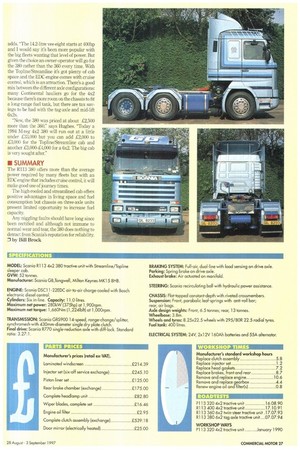• Back in 1991 we predicted that continually rising fuel
Page 24

Page 26

Page 27

Page 28

Page 29

If you've noticed an error in this article please click here to report it so we can fix it.
prices would be the one sure thing in transport throughout the decade—we didn't realise that successive governments would impose a "green tax" on top of inflation.
Last year road users paid about £28bn in tax; this year, rises in VED and fuel tax will add another L2bn, while road-building programmes are being axed. Of the total revenue only ..f..8bn has been allocated to road building and maintenance this year.
Don't be surprised if the surplus of more than L2Obn disappears into the Chancellor's coffers.
Our prediction for the rest of the decade is that traffic jams will get worse, trucks will find it more difficult to meet delivery schedules and ever more fuel will be wasted by stationary vehicles.
Truck operators are being forced to pay twice, having already paid hefty premiums to meet environmental legislation in the form of more expensive Euro-1 and Euro-2 diesels. What was not foreseen is that most of these engines are not simply greener than their predecessors; they're also more efficient, which is an added benefit to the environment.
• EVOLUTION
Scania's R113 tractor range was a surprise exhibit at the Geneva motor show early in 1988. It became available in the UK from about March of the same year in 4x2 and 6x2 twin-steer and tag-axle configurations.
However, due to supply problems, not many were registered before the introduction of the F-plate. Although corner deflectors and mirror cowlings had been added the outward appearance was very similar to the 2 Series, but a number of mechanical changes and a revised cab layout with improved trim levels ensured that the new model was a major step forwards.
The 4x2s incorporated parabolic suspension with anti-roll bars front and rear. Optional air suspension on the 6x2 increased rear swing clearance while taper-rollered king pins reduced steering loads at the wheel. On twin-steer models the steering linkage was rerouted to allow easier PTO mounting.
The 3-Series range was initially introduced with the 11-litre engine which, at a nominal 360hp, proved to be the most popular rating. With a later Euro.1 version it lasted up to the introduction of the current 4-Series this year.
A 320hp version was introduced in 1991 but more power was offered by the 380 for the last three years of 3-Series production.
The Streamline aerodynamic package with the taller Topline roof became available from 1991. It was not a full-height roof but served as a reasonable compromise that added to much-needed headroom inside.
• OPERATORS
In 1986 Peter Barrett moved from the Gloucester area to Market Rasen in Lincolnshire where he established Top Road Haulage with a single Scania Rill tractive unit. Barrett has remained loyal to the marque and now runs three Scanias, including a K-reg tag-axled 6x2 380 ex-demonstrator that was the unit we tested in 1994.
"I subcontract out of Immingham and needed an extra vehicle to cope with the work," says Barrett. "My local dealer, Scanlink of Grimsby, told me about the demonstrator and invited me to make a closed bid for it. Apparently I offered £300 more than anyone else so you might say I paid too much for it I didn't actually need 380hp, both my other units are 360s, but with the possibility of 44 tonnes it seemed a good idea to have a threeaxle unit in the fleet. Normally our maximum payload would be restricted to 22.3 tonnes. It's not always heavy work but we mostly gross at over 32 tonnes. The 380 runs on six axles, mainly for the tax advantage, and it has been
a bit of a flagship for us. I thought the later Nreg 360 4x2, which I purchased in January 1996, was more economically viable at the time.
"It might seem a step in the wrong direction," he adds, "but it was an addition to the business and cost was a prime consideration. Our next purchase will almost certainly involve a trade-in, and with the trend being towards higher power we'll be looking in that direction. In time we would like to be able to change vehicles every three years.
"All of my trucks are maintained by Scanlink," says Barrett. "The N-reg is still covered under the 2-plus-2 scheme which I intend to extend at the beginning of next year. The service contract for both K and G-reg vehicles is based on 160,000km per year with an inspection every 15,000km and a service every 30,000km. When we purchased the 6x2 380 we spread our maintenance costs by paying a monthly sum of Liii.98 (ex-VAT). This is rather expensive for a small business but the costs are fixed and we feel it is the best option for the standards we set for ourselves.
"Scania tractors have an excellent record for fuel consumption but the driver is just as important," he points out. "We monitor fuel closely and keep the driver informed of his mpg—if performance drops below expectations for any length of time we have the dealer check the vehicle oven It's a policy that has worked well for me. Fuel costs are less for the N-reg 4x2. Because its tanks have a capacity of 1,000 litres we mostly fill at base. The 6x2 has space on the chassis for only 500 litres so
we have to buy more fuel out at higher cost. There's a lot of drag from six axles; it's averaging 8.3mpg against 8.7mpg for the later 4x2 360. If I buy another three-axled unit it will be a twin-steer because tyre scrub is less and you can lift the second steer axle if running light.
"The 6x2 380 has extras that we would not normally specify and it has been more expensive to maintain than we had hoped," Barrett remarks. "Initially we had to modify the back of the chassis to clear the trailer. Within the first year the exhaust pipe cracked in front of the expansion chamber. Then the turbocharger housing blew apart and we've had a number of electrical faults, mainly put right with new relays costing 1,80 to £100 a time. We've also had a new alternator and had to replace one of the rear air bags. Although the front shock absorbers started to leak on our G-reg 4x2 I have not needed to renew them yet on the K-reg 6x2. Despite its faults it hasn't cost us any serious unscheduled time off the road and the engine still doesn't use any oil to talk of.
"The Topline cab gives the driver a bit more space," he says, 'but one of my beefs is that it didn't come with a separate side locker big enough to take a tool box, straps and gloves etc—you don't want them inside. I'm told one is available on the 4-Series and I am sure it came about by demand, Occasionally I have hired in different makes of vehicles but I find that Scanias have that bit extra and fuel is a priority. I'm happy with the power of the 380 but it takes a good driver to get the best out of it and I may have trouble getting him to part with it when the time comes."
Fruit of the Loom is one of the biggest names in leisure wear. Transport manager Kim Alvey dispatches a fleet of three Scanias from Telford around the country; his 4x2 ToplineiStreamline R113 380 tractive unit was bought three years ago to run doublemanned into Germany but, like his other two vehicles, it also now operates 90% of the time in the UK.
"We decided on Scania because of the build quality," he says. "It can't be beaten, and the 380 was the best specification available with the 11-litre EDC engine. We don't have back.
loads so we only run laden for 50% of the time. We top out at about 25 tonnes gross and get around 9.5mpg. Generally speaking it's been excellent though there were a few little quirky things that I would describe as teething troubles.
"The EDC played up a bit at first with the panel lights coming on for no apparent reason," he recalls. "A couple of times the cruise control stopped working properly, and we have had a problem with the seat belt on the driver's seat, but these were rectified by the dealer early on. We're doing 120,000km a year and we haven't changed any of the tyres yet.
"I think that the 3 Series is still a better model overall than the 4-Series," says Alvey. "I believe that Scania is in the process of bringing in a walk-through cab which I would be interested to see. Right now we're in the process of getting another rigid—we've had a look at different demos but it looks as though it will be a Scania again. The initial price is higher but it's worth paying a bit more up front because when it comes to residuals they can't be beaten and that comes back to the quality of the build again."
Geoff Gilbert has been in business in the Boston area for the past 28 years. His company, Geoff Gilbert Inter
national, specialises in refrigerated loads. To get the right weight distribution most of his 27 vehicles are twin-steers, and they're all Scanias.
"I run on six axles," he says. "There is a small tax benefit but I would prefer to operate with two-axled units with a heavier drive axle like they do on the Continent I tried the tagaxled unit before the twin-steers came in but they were not suitable for our operation—the handling was bad and so was manoeuvrability. With the tag you can't couple up as close to a fridge as you can with a twin-steer and with two axles steering it takes out a lot of the drag,
"I've always bought what I thought was best value for money," says Gilbert. "I ran Volvos when! first started and my first Scania was a T-reg 111. We have another company, G Trucks, which has since become a Scania service agent. It makes sense to operate what you sell and service but Scania is still the best truck on the market. I think we run every power option that Scania has made, from 320 to 500hp.
"The 380 is very good on fuel, it's very reliable and maintains a good residual value," he adds. "I keep them a long time. Why change them if they're performing all right? In some cases I keep them for seven to eight years or even longer. They're well looked after and we have a ready market for them. We always sell them privately. Every vehicle is monitored closely and we run a fuel competition among the drivers. Our fleet average is 8.0mpg and the 380 is as good a truck as you can have for fuel. I was a bit sceptical about the EDCs when they came in—it was something else to go wrong—but I don't even think about it now.
We have Topline/Streamline cabs but we haven't any of the 4-Series yet. I've just bought a 450 and a 500 from Scania, but unless you need that amount of power for a special job, 380hp is enough for 38 tonnes. The power doesn't make a lot of difference to journey times . We run throughout Europe and they all go out and come back in about the same time but the drivers like the biggest available."
To find out if there were any weak spots worth reporting we talked to Dave Richardson, Gilbert's workshop manager. "There isn't anything that keeps recurring," he says. "On the early ones Scania used a multi-plug connector to the injection pump: if damp got in it would flash up on the dash as an EDC fault. There isn't a joint in the loom on the newer ones. The driveline generally isn't a problem as we operate one driver to a vehicle. If there is one thing that we've had to keep an eye on it's the flexy clutch pipe from the master cylinder. With age and movement of the cab they do tend to split at the bottom end. "On brakes we get up to two years out of one set of linings and a lot longer for the rears, says Richardson. "We've been using 295s on the front axle which we swap to the second steer after 180,000km but we've been trying out Toyo 385 super-singles.
"Over 12 months they've only worn from 15mtn to 12nun in 140,000km which is very encouraging.
"All of the twin-steers have autolube fitted which has virtually eliminated wear problems with spring pins and bushes on front and second steer axles."
• DEALERS
The 380 only dates back for three years, so few examples are to be found among the ranks of independent dealers. We duly headed down to Smitruck of Purfleet, an independently run but wholly owned Scania dealership with a separate branch at South Mimms. Used truck sales manager Keith Hughes, based at Purfleet, usually keeps a stock of 30 used vehicles of 17 tonnes and above.
"As well as tractive units we sell a lot of six-wheel rigids," he says. "Most of our stock is less than six years old and comes within the Scania approved truck scheme. These trucks have been serviced and given a good check over so that we are confident to offer them with a two-year warranty.
"Although the 360 is a very popular vehicle we don't see that many R113 380s which use the most powerful version of the straight-six 1I-litre engine," he
adds. "The 14.2-litre yee-eight starts at 400hp and I would say it's been more popular with the big fleets wanting that level of power But given the choice an owner-operator will go for the 380 rather than the 360 every time. With the Topline/Streamline it's got plenty of cab space and the EDC engine comes with cruise control, which is an attraction. There's a good mix between the different axle configurations: many Continental hauliers go for the 4x2 because there's more room on the chassis to fit a long-range fuel tank, but there are tax savings to be had with the tag-axle and mid-lift 6x2,s.
"New, the 380 was priced at about £2,500 more than the 360," says Hughes. "Today a 1994 M-reg 4x2 380 will run out at a little under 1:33,(XX) but you can add £2,000 to £3,000 for the Topline/Streamline cab and another f3,000-,£4,000 for a 6x2. The big cab is very sought after."
• SUMMARY
The R113 380 offers more than the average power required by many fleets but with an EDC engine that includes cruise control, it will make good use of journey times.
The high-roofed and streamlined cab offers positive advantages in living space and fuel consumption but chassis on three-axle units present limited opportunity to increase fuel capacity
Any niggling faults should have long since been rectified and although not immune to normal wear and tear, the 380 does nothing to detract from Scania's reputation for reliability 1 by Bill Brock
































































































